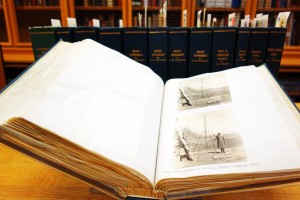The Robert H. Goddard Papers and the Smithsonian
Over a decade before Wernher von Braun and his colleagues jumpstarted the space age with the V-2 (or A-4) rocket, Robert H. Goddard was conducting experiments in the New Mexican desert on rockets powered by liquid fuel. After years of testing, the financially-strapped professor from Princeton appealed to the Smithsonian Institution for support to continue his experiments. In a letter to the Smithsonian Institution written in September 1916, Goddard requested, among other things, that the Smithsonian provide assistance in terms of financial support and critical feedback to further his research.[1]
The collaboration between the Smithsonian and Goddard began with a $5,000 grant from the Thomas George Hodgkins Fund.[2] Fostered by Charles Greely Abbott, the initial recipient of Goddard’s proposal, the twenty-nine year relationship between the Smithsonian and Goddard was mutually beneficial in that it provided the rocket scientist with both the means to conduct his experiments and an outlet to publish his findings. In a poetic twist, the Smithsonian had financed research which provided one of the founding elements for the National Air & Space Museum (NASM). At the urging of his peers, Daniel Guggenheim and Charles Lindbergh, Goddard donated a 1934 Series A rocket to the Smithsonian.[3] This rocket is now currently on display at the Steven F. Udvar-Hazy Center in Chantilly.

Eventually dubbed as one of the “Fathers of Rocketry,” Goddard passed away on August 10, 1945—three days after the United States dropped the first atom bomb on Japan. Though experts and peers determined that Goddard’s patents were not a direct influence on Wernher von Braun and the development of the V-2 rocket, von Braun later testified, “”Goddard’s experiments in liquid fuel saved us years of work, and enabled us to perfect the V-2 years before it would have been possible.”[4]
In addition to the backing he received from the Smithsonian, Goddard received support from such respected figures as Charles Lindbergh, who advocated and promoted the potential of Goddard’s work, and both Daniel and Harry Guggenheim, who donated almost $200,000 towards Goddard’s continued research. However, his strongest advocate was his wife, Esther, who went to great lengths to secure Goddard’s legacy in the years following his death.
Evidence of her success at promoting her late husband’s contributions to science and aerospace materialized in the form of the Congressional Gold Medal in 1959, Smithsonian’s Langley Gold Medal in 1960 and NASA’s naming of the Goddard Space Flight Center. Additionally, Mrs. Goddard oversaw the transcription and publication of her husband’s notes, which would become the Robert H. Goddard Papers.
Housed in special collections in the DeWitt Clinton Ramsey Room of the NASM library, the Robert H. Goddard Papers contain a wealth of information relating to the history of early rocketry. Financed by the Guggenheims, the twenty-three volume collection is comprised of 5,500 pages of notes, 2,600 photographs, and 500 copies of Goddard’s drawings—spanning the years 1921-1943.[5] Among the topics covered in the papers are the usage of gyroscopes, experiments with liquid fuel, fuel tank construction, steering, turbine controls, launching, and parachutes design. While the original, handwritten version of the Robert H. Goddard Papers are housed at the Roswell Museum and Art Center in New Mexico, additional papers are located in the Special Collections wing of Clark University’s Robert H. Goddard Library. Because access to the Ramsey Room is limited, researchers are recommended to contact NASM Library staff (AskaLibrarian@si.edu) in advance to schedule an appointment.

[1] Digitized copies of Goddard’s early correspondence with the Smithsonian Institution can be found at http://siarchives.si.edu/history/exhibits/stories/september-27-1916-goddards-proposal-smithsonian
[2] Clary, David A. Rocket Man: Robert Goddard and the Birth of the Space Age. (New York: Hyperion, 2003), 60-62.
[3] Durant, Frederick C., III. Robert H. Goddard and the Smithsonian Institution. (Presented at 2d Symposium on the History of Astronautics, International Academy of Astronautics, 19th Congress of the International Astronautical Federation, 1968), 8.
[4] Mosley, Leonard. Lindbergh: A Biography. (Garden City, NY: Doubleday, 1976), 344.
[5] Clary, David, 242

Be First to Comment